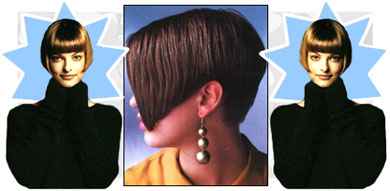Bob (hair)

Fashion Synopsis
Nothing says sleek sophistication better than the soft, but severe cut of the cropped bob. From its first inception during the 20’s 'Castle crop,' when women lopped off their crowning glory for a taste of freedom and frivolity, to the severe geometric points of the 60’s Sassoon cut, the bob represents assertive femininity.
The bobs of the 20’s were shocking not for their style, but for their length: women prided themselves on their long and luxurious hair, and took great care in the full pompadours of the ‘Gibson girl’ poof at the turn of the century. But when women won the vote, ladies loosened the constrictive corset, skirt hemlines rose to the knees, and girls cropped their hair into the short style of the bob. The ‘flapper’ shook things up, and in her chin-length cut, she infected a moralistic, conservative society with a daring new do.
American dancer Irene Castle had cut her locks as a bold move towards freedom and equality with men. Many ladies followed, requesting the chic ‘Castle crop’ from their local haircutters. Fashion designer Coco Channel, screen siren Gloria Swanson, and screenwriter Anita Loos all traded in their manes for the bob. The 20’s bob featured the short, boylike Eaton crop, the soft full body at chin length, or a flat head of waves called marcels. During the latter half of the 20’s, a little known actress shot into superstardom because of her blunt cut bob: Louise Brooks (the Jennifer Aniston or Farrah Fawcett of the 20's). She remains more famous today for her severe black bob than for her movies.
The bob faded into the background by the end of the 30’s, replaced by a more carefully tended set and curl style. The 40’s cuts were shoulder length, with elaborate curls and pin-ups. The 50’s returned short hair, but bypassed the bob for the ultra-short ‘Italian boy look.’ It wasn’t until the 60’s that the bob returned, this time updated for the space-age stylings of the swinging 60’s. Hair designer Vidal Sassoon turned the bob into mathematical science and geometric art. Mini-skirt maven Mary Quant requested specially created hairdos for her store window mannequins: it seemed that long hair was distracting to the distinctive collars of her new youthful designs. Vidal Sassoon accommodated her request and created the severe lines of the modern bob.
Vidal treated hair as a shape, not to be molded like the teased and set beehive, but sculpted. His scissors and razors cut the design into the hair as if it were a block of marble to be chiseled from. Vidal’s avant-garde cuts were popularized by Mary Quant herself, and by a striking Asian screen star, Nancy Kwan. The stiff, straight style of Asian hair was a perfect platform for the sharp geometric styles of the new cut. Bangs were cut blunt across the forehead, or angled severely over one eye. Points were shaped into the hair, and asymmetrical lines moved and swung, but fell effortlessly back into place. It was the epitome of modern: wash and go, yet with a distinctive, futuristic feeling.
The 80’s saw the return of bobs, but this time they took the extreme styles of the 60’s and went even wilder. Asymmetrical cuts featured distinctive designs wherein one side of the hair was short, and the other side drastically longer. This bob was different than it had ever been before. The punk influence turned the bob into colorful sculpture as hairdyes updated the look, and hair was reinvented as art.
